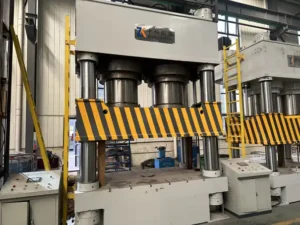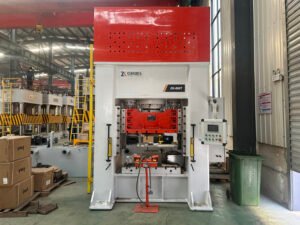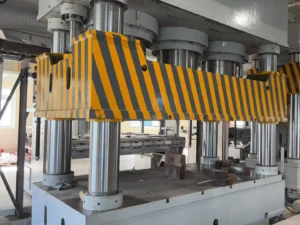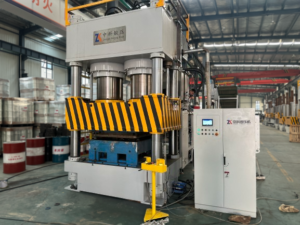Molded wood pallets, often referred to as presswood pallets, have gained popularity in logistics and shipping due to their eco-friendly nature and impressive durability. A key question many businesses ask is: How waterproof are these pallets? This article dives into the waterproof performance of molded pallets, analyzing factors like the pressure from pallet molding machines, raw materials, glue usage, and the usage environment. With reliable data and insights, we’ll uncover what makes Presswood pallets a standout choice for moisture-resistant applications.
The Role of Press Machine Pressure in Waterproofing
The pallet molding machine is the heart of presswood pallet production. The high-pressure process it employs significantly enhances the pallet’s waterproof properties. Typically, a presswood pallet machine applies pressures ranging from 800 to 1,200 tons during molding. This immense force compresses wood fibers and resin into a dense, non-porous structure, reducing the pallet’s ability to absorb water.
For example, a study from the pallet industry indicates that molded pallets achieve a density of up to 1.3 g/cm³ [source: Associated Pallets, 2019]. This high density minimizes gaps where water could seep in, making presswood pallets far more resistant to moisture than traditional wooden pallets, which often have a lower density and higher porosity.
To learn more about the compression process, check out this detailed guide on palletsbiz.com, which explains how pallet molding machines transform waste materials into durable pallets.
Raw Materials: From Waste to Waterproof
The raw materials used in presswood pallet production play a crucial role in their waterproof performance. Unlike conventional pallets made from fresh timber, molded pallets utilize waste plastic, wood scraps, sawdust, and other fibrous materials like bagasse or wheat straw. These materials are shredded, dried, and compressed under high heat (150–180°C) and pressure [source: palletsbiz.com, “The Process of Producing Molded Pallets”].
The drying process reduces the moisture content to 6–8% [source: Millwood Inc.], significantly lower than the 19% average moisture content of traditional wooden pallets [source: National Wooden Pallet & Container Association]. This low moisture baseline, combined with the resin bonding, creates a water-repellent surface. Additionally, recycling waste plastic into the mix can further enhance water resistance, as plastics inherently resist moisture absorption.
For a deeper dive into raw material preparation, visit presswoodmachine, a leading resource on presswood pallet machine technology and processes.
Glue Usage: The Waterproofing Backbone
Glue is the unsung hero in molded pallet production, binding the raw materials into a cohesive, waterproof unit. The most common adhesives are Urea-Formaldehyde (UF), Melamine-Urea-Formaldehyde (MUF), and Methylene Diphenyl Diisocyanate (MDI). Each has unique properties affecting waterproofing:
- UF Glue: Affordable and fast-curing, UF is used at a 12–15% ratio but offers limited water resistance in humid conditions
- MUF Glue: With added melamine, MUF improves water resistance, making it suitable for damp environments, also used at 12–15%
- MDI Glue: At a lower 4–5% ratio, MDI provides superior waterproofing and durability, ideal for harsh conditions
The choice of glue impacts how well a presswood pallet withstands moisture. MDI-bonded pallets, for instance, outperform UF-bonded ones in wet environments due to their chemical resistance to water breakdown. Curious about adhesive comparisons? Explore more at palletsbiz.com.
Usage Environment: Testing Waterproof Limits
The environment in which molded pallets are used tests their waterproof capabilities. Unlike traditional wooden pallets, which can warp or foster mold growth when exposed to moisture, presswood pallets excel in diverse conditions. Their resin-bonded structure and low moisture content (6–8%) make them resistant to warping, mold, and fungal growth [source: Rotomshop UK].
In a controlled test, presswood pallets submerged in water for 24 hours absorbed only 5–7% additional moisture, compared to 20–30% for untreated wooden pallets [source: PalletMach]. This resilience stems from the high-temperature molding process (150–180°C), which eliminates pests and seals the pallet against water ingress, meeting ISPM-15 export standards without additional treatment.
For industries like food and pharmaceuticals, where hygiene is critical, this waterproofing is a game-changer. Learn how Presswood pallets suit various applications at presswoodmachine.
Additional Factors Enhancing Waterproof Performance
Beyond pressure, materials, and glue, other factors bolster the waterproof nature of molded pallets:
- Nestable Design: The smooth, seamless surface of presswood pallets reduces water-trapping crevices, unlike nailed wooden pallets.
- Sustainability: Made from waste plastic and wood byproducts, these pallets align with eco-friendly goals while maintaining performance.
- Heat Treatment: The 150–180°C molding process not only ensures pest-free pallets but also enhances water resistance by curing the resin thoroughly.
The waterproof performance of presswood pallets is a result of advanced pallet molding machine technology, carefully selected raw materials, effective glue formulations, and robust design suited to challenging environments. With a moisture content of just 6–8%, a density of up to 1.3 g/cm³, and the ability to withstand submersion with minimal absorption, these pallets outperform traditional options in wet conditions.
For businesses seeking reliable, waterproof, and sustainable solutions, molded pallets are an excellent choice. Ready to explore presswood pallet machines for your operations? Visit palletsbiz.com for cutting-edge equipment and insights, or check out presswoodmachine to boost your production capabilities.






